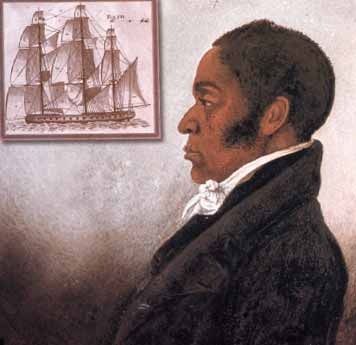| This past fall I participated in Amazing Grace: How Writers Helped End Slavery, a masters level course offered by the Gilder-Lehrman Institute of American History. The course, led by Columbia Professor, and GLI President, James Basker, examined the role of abolitionist writers in the 19th century struggle to end that "peculiar institution." The final project was to compile our own abolitionist writing anthology that could be used in the classroom. I wanted to share the work I generated during this course as perhaps the primary sources I chose could prove useful in your own classrooms. In this blog "mini-series" (Amazing Grace) I will share with you my reflections, my anthology introductions, and the sources themselves. Most, if not all, of the sources I reference can be found in James Basker's book American Antislavery Writings: Colonial Beginnings to Emancipation. |
Putting primary sources into conversation:
James Forten’s Letters and the anonymous ballad, The African Slave
James Forten’s Letters and the anonymous ballad, The African Slave
Reflection:
In my 7th grade history class, students investigate the struggle of abolition as a process. From chattel slavery, to the North West Ordinance, the importation ban, the failed compromises, etc, until we arrive at the Reconstruction Era amendments (we pick up the civil rights struggle in the 8th grade). The two texts that best fit into this conversation and illustrate the constant push for abolition and the curious situation of free-blacks in America at the time, are James Forten’s Letters and the anonymous ballad, The African Slave.
The first person account of Itaniko’s capture, attempted escape/suicide, role in talking down a rebellion, and mancipation directly to the aversion to and surprise at the actions of these “Christian” men: “You boast of your Freedom … your mild Constitution.” Thus dispelling the philanthropic argument of Christianizing and improving the enslaved African’s lot in life. The eloquence and emotion of the ballad clearly captures well the sufferings of the Africans captured and transported into slavery.
The second piece, Forten’s Letters, is a curious continuation of the struggles of Africans in the Americas. Though the slave trade now abolished, Forten speaks of the injustices and inconsistencies in the application of the words of the Constitution. Harkening to the Constitution, Forten says “… declaring ‘all men’ free, they did not particularize white and black, because … [they weren’t supposed to] question whether we were men or not.” Forten here not only exposes the hypocrisies in the document, but illustrates that mere emancipation is not enough to elevate the enslaved peoples to the true status of citizen, or even man. Seeing Pennsylvania as one of the last bastions of liberty for free black men, he laments that the newly proposed bill would render them slaves again – in the stripping of their liberties, movements, and property.
These two documents interacting will help my students to see the slow progression towards achieving the ideals in the Constitution through emancipation. That once removed from the bonds of chattel slavery, the free African was no more free in some respects than his enslaved brethren. The long, unsteady march towards full equality would be, as with many things, two steps forward and one step back for many more years to come.
In my 7th grade history class, students investigate the struggle of abolition as a process. From chattel slavery, to the North West Ordinance, the importation ban, the failed compromises, etc, until we arrive at the Reconstruction Era amendments (we pick up the civil rights struggle in the 8th grade). The two texts that best fit into this conversation and illustrate the constant push for abolition and the curious situation of free-blacks in America at the time, are James Forten’s Letters and the anonymous ballad, The African Slave.
The first person account of Itaniko’s capture, attempted escape/suicide, role in talking down a rebellion, and mancipation directly to the aversion to and surprise at the actions of these “Christian” men: “You boast of your Freedom … your mild Constitution.” Thus dispelling the philanthropic argument of Christianizing and improving the enslaved African’s lot in life. The eloquence and emotion of the ballad clearly captures well the sufferings of the Africans captured and transported into slavery.
The second piece, Forten’s Letters, is a curious continuation of the struggles of Africans in the Americas. Though the slave trade now abolished, Forten speaks of the injustices and inconsistencies in the application of the words of the Constitution. Harkening to the Constitution, Forten says “… declaring ‘all men’ free, they did not particularize white and black, because … [they weren’t supposed to] question whether we were men or not.” Forten here not only exposes the hypocrisies in the document, but illustrates that mere emancipation is not enough to elevate the enslaved peoples to the true status of citizen, or even man. Seeing Pennsylvania as one of the last bastions of liberty for free black men, he laments that the newly proposed bill would render them slaves again – in the stripping of their liberties, movements, and property.
These two documents interacting will help my students to see the slow progression towards achieving the ideals in the Constitution through emancipation. That once removed from the bonds of chattel slavery, the free African was no more free in some respects than his enslaved brethren. The long, unsteady march towards full equality would be, as with many things, two steps forward and one step back for many more years to come.



 RSS Feed
RSS Feed

